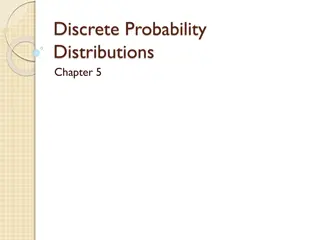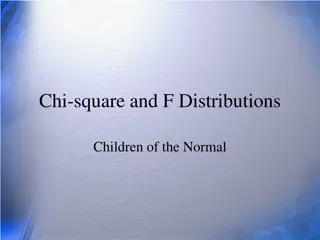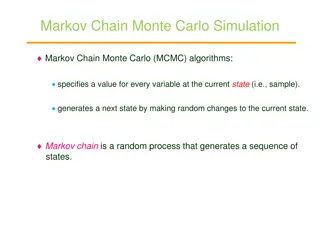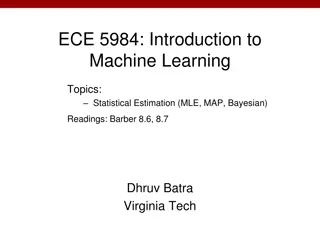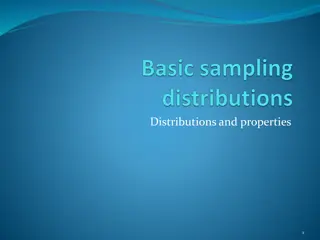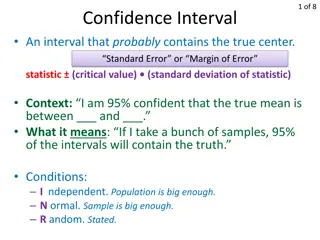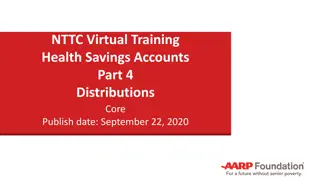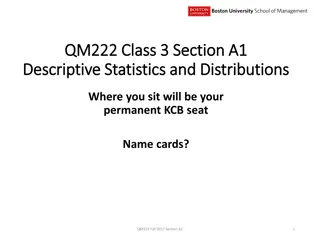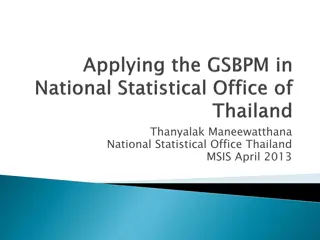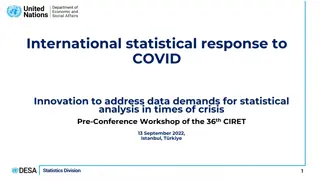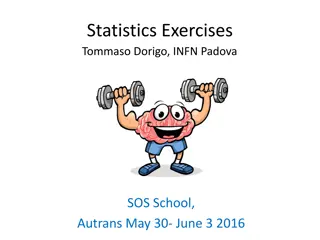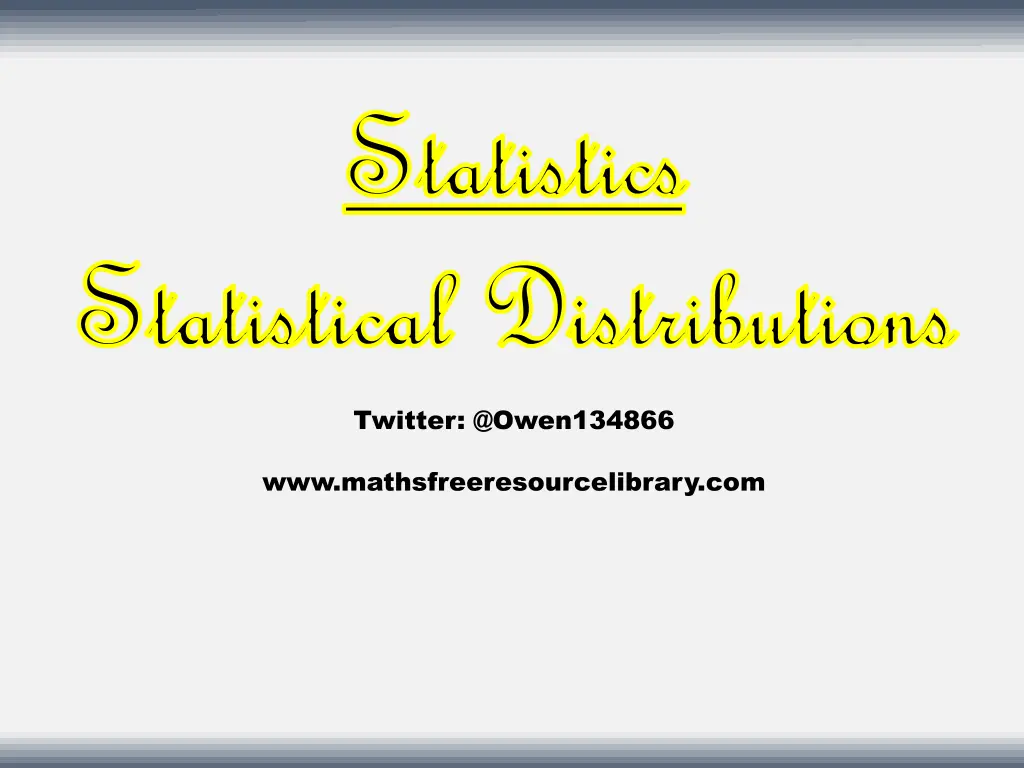
Understanding Probability Distributions for Data Analysis
Learn about statistical distributions and how to interpret probability in data analysis. Understand concepts like random variables, sample spaces, and discrete uniform distributions to enhance your statistical knowledge for effective decision-making.
Download Presentation

Please find below an Image/Link to download the presentation.
The content on the website is provided AS IS for your information and personal use only. It may not be sold, licensed, or shared on other websites without obtaining consent from the author. If you encounter any issues during the download, it is possible that the publisher has removed the file from their server.
You are allowed to download the files provided on this website for personal or commercial use, subject to the condition that they are used lawfully. All files are the property of their respective owners.
The content on the website is provided AS IS for your information and personal use only. It may not be sold, licensed, or shared on other websites without obtaining consent from the author.
E N D
Presentation Transcript
Statistics Statistics Statistical Distributions Statistical Distributions Twitter: @Owen134866 www.mathsfreeresourcelibrary.com
Prior Knowledge Check 2) Two fair dice are rolled. Calculate the probability that the sum of the scores on the dice is: a) 5 b) Even c) Odd d) Prime e) A multiple of 3 1) Three coins are flipped. Calculate the probability that: All land on tails All land on heads Exactly one lands on tails At least 2 land on heads ? ? ? ? a) b) c) d) ? ? ? ? ? ? ? ? ? ? ? ? ? ??
Teachings for Teachings for Exercise 6A Exercise 6A
Statistical Distributions You need to be able to understand and use probability distributions This chapter focuses on Discrete Random Variables A random variable is a variable whose value depends on the outcome of a random event These are values which can only take certain numerical values, each of which can be assigned a probability For example, when we roll 5 dice, the number of sixes rolled would be a random variable For example, the number of times a 1 is rolled when rolling a dice 10 times The range of values the random variable can take is called a sample space, and is often drawn as a table It can only take certain numerical values A discrete variable can only take certain countable numerical values Each can be assigned a probability For example, the number of people has to be a whole number 6A
Statistical Distributions You need to be able to understand and use probability distributions The letter ? represents the event we are considering, and includes all the possible outcomes A probability distribution fully describes the probability of any outcome in the sample space ? 1 2 3 4 5 6 1 6 1 6 1 6 1 6 1 6 1 6 For example, for the random variable: ? = ????? ? ?? ? ???? ???? ?? ?????? ?(? = ?) The lower row means The probability of an observation being equal to ? If all the probabilities are the same, it is known as a discrete uniform distribution In this case, The probability of the score when a fair dice is rolled being equal to ?(the top row) 6A
Statistical Distributions There are 4 possibilities for the number of heads: 0, 1, 2 or 3 You need to be able to understand and use probability distributions Three fair coins are tossed. ? 0 1 8 1 3 8 2 3 8 3 1 8 1 8 3 8 3 8 1 8 a) Write down all the possible outcomes when the three coins are tossed. H H H H T H T H H T T H ?(? = ?) Remember that ? represents the event we are considering, and includes all possible outcomes H H T T H T H T T T T T A random variable, ?, is defined as the number of heads when the three coins are tossed. The bottom row is the probabilities of each event happening b) Write the probability distribution of ? as: i) A table A probability mass function ii) 6A
Statistical Distributions You need to be able to understand and use probability distributions ? 0 1 8 1 3 8 2 3 8 3 1 8 1 8 3 8 3 8 1 8 ?(? = ?) Three fair coins are tossed. A probability mass function summarises the probabilities and events which take those values a) Write down all the possible outcomes when the three coins are tossed. H H H H T H T H H T T H H H T T H T H T T T T T 1 8 3 8 0 ? = 0,3 ? ? = ? = ? = 1,2 A random variable, ?, is defined as the number of heads when the three coins are tossed. ?? ?????? b) Write the probability distribution of ? as: i) A table A probability mass function Each probability is included here The outcomes which take the corresponding probability are listed here ii) 6A
Statistical Distributions You need to be able to understand and use probability distributions ? 0 1 8 1 3 8 2 3 8 3 1 8 1 8 3 8 3 8 1 8 ?(? = ?) Three fair coins are tossed. a) Write down all the possible outcomes when the three coins are tossed. H H H H T H T H H T T H H H T T H T H T T T T T Note that since the table represents all possible outcomes, the sum of the probabilities must be equal to 1 A random variable, ?, is defined as the number of heads when the three coins are tossed. ? ? = ? = 1 ??? ??? ? b) Write the probability distribution of ? as: i) A table A probability mass function ii) 6A
Statistical Distributions You need to be able to understand and use probability distributions A biased four sided dice with faces numbered 1, 2, 3 and 4 is rolled. The number on the bottom face is modelled as a random variable ?. Think about this You are being told that the probability of the number being rolled is equal to ? divided by that number Given that ? ? = ? =? ? a) Find the value of ? b) Give the probability distribution of ? in table form. 6A
Statistical Distributions You need to be able to understand and use probability distributions There are 4 possible outcomes for the dice: 1, 2, 3 and 4 A biased four sided dice with faces numbered 1, 2, 3 and 4 is rolled. The number on the bottom face is modelled as a random variable ?. ? 1 ? 1 2 ? 2 3 ? 3 4 ? 4 1 8 3 8 3 8 1 8 ?(? = ?) Remember that since all outcomes are represented, the probabilities should add up to 1 Given that ? ? = ? =? ? a) Find the value of ? b) Give the probability distribution of ? in table form. ? 1+? 2+? 3+? 4= 1 Multiply by 12 12? + 6? + 4? + 3? = 12 Group like terms 25? = 12 Divide by 25 ? =12 25 6A
Statistical Distributions You need to be able to understand and use probability distributions ? 1 ? 1 25 2 ? 2 25 3 ? 3 25 4 ? 4 25 12 6 4 3 1 8 3 8 3 8 1 8 ?(? = ?) A biased four sided dice with faces numbered 1, 2, 3 and 4 is rolled. The number on the bottom face is modelled as a random variable ?. Now we know that ? =12 the actual probabilities 25, we can calculate Given that ? ? = ? =? ? ? =12 a) Find the value of ? b) Give the probability distribution of ? in table form. 25 6A
Statistical Distributions You need to be able to understand and use probability distributions ? 1 2 3 4 12 6 4 3 1 8 25 3 8 25 3 8 25 1 8 25 ?(? = ?) A biased four sided dice with faces numbered 1, 2, 3 and 4 is rolled. The number on the bottom face is modelled as a random variable ?. The probability that a random observation is greater than 2 7 = ? ? > 2 25 The probability that a random observation is between 1 and 4, non- inclusive Given that ? ? = ? =? =10 25 =2 5 ? ? 1 < ? < 4 c) Find the Probability that: i) ? > 2 ii) 1 < ? < 4 iii) ? > 4 The probability that a random observation is greater than 4 ? ? > 4 = 0 6A
Statistical Distributions You need to be able to understand and use probability distributions ? 1 2 3 4 2 1 8 5 3 8 3 8 1 8 ?(? = ?) The spinner below is spun until it lands on red, or has been spun 4 times in total. Find the probability distribution of the random variable ?, the number of times the spinner is spun. 2 5 ? ? = 1 = The probability that the number of spins is 1 (ie we get a red on the first spin) 6A
Statistical Distributions You need to be able to understand and use probability distributions ? 1 2 3 4 2 6 1 8 5 3 8 25 3 8 1 8 ?(? = ?) The spinner below is spun until it lands on red, or has been spun 4 times in total. Find the probability distribution of the random variable ?, the number of times the spinner is spun. 3 5 2 ? ? = 2 = 5 6 = 25 The probability that the number of spins is 2 (ie we get a red on the second spin) This means we need to get blue and then red 6A
Statistical Distributions You need to be able to understand and use probability distributions ? 1 2 3 4 2 6 18 125 1 8 5 3 8 25 3 8 1 8 ?(? = ?) The spinner below is spun until it lands on red, or has been spun 4 times in total. Find the probability distribution of the random variable ?, the number of times the spinner is spun. 3 5 3 5 2 ? ? = 3 = 5 18 125 = The probability that the number of spins is 3 (ie we get a red on the third spin) This means we need to get blue and then blue and then red 6A
Statistical Distributions You need to be able to understand and use probability distributions ? 1 2 3 4 2 6 18 125 27 125 1 8 5 3 8 25 3 8 1 8 ?(? = ?) The spinner below is spun until it lands on red, or has been spun 4 times in total. Find the probability distribution of the random variable ?, the number of times the spinner is spun. 2 5+ 6 18 125 ? ? = 4 = 1 25+ 27 125 = The probability that the number of spins is 4 In this case it does not matter whether we get red or blue Spinning 4 times is equivalent to not stopping after 1, 2 or 3 spins (since we will not go above 4) 6A
Teachings for Teachings for Exercise 6B Exercise 6B
Statistical Distributions The probability for the first combination listed will be calculated by: The Binomial distribution can be used to model the number of times a trial is successful 2 3 2 3 2 3 1 3 1 3 Gary is playing chess against Nigel, and has a 2 game. If they play 5 games, what is the probability of Gary winning exactly 3? 3 chance of winning each Gary wins the first 3, then Nigel wins the last 2 All the other combinations will give the same answer, since they contain the same mix of probabilities How many ways can Gary win 3? G G G N N G G N G N G G N N G G N G G N G N G N G G N N G G N N G G G N G G G N N G G N G N G N G G Therefore, the complete calculation is as follows: 3 2 2 3 1 3 10 There are 10 in total = 0.329 6B
Statistical Distributions The Binomial distribution can be used to model the number of times a trial is successful Find the term containing ?3 in the following expansion: ? + ?5 Use the formula learnt in the pure maths book 5 2 ?3?2 = 10?3?2 6B
Statistical Distributions The Binomial distribution can be used to model the number of times a trial is successful If the probability of Gary winning a chess match is 2 the probability of him winning exactly 3 games out of 5 3, find Find the term containing ?3 in the expansion of ? + ?5 3 2 2 3 1 3 = 10?3?2 = 10 These questions are essentially the same! This section looks at using a binomial distribution for calculating probabilities 6B
Statistical Distributions The Binomial distribution can be used to model the number of times a trial is successful To use the Binomial distribution, a number of conditions must be met There are a fixed number of trials There are 2 possible outcomes (you can think of them as success or failure) The probability of success is the same each time The trials are independent of each other (the outcome of one trial does not affect the next trial ) 6B
Statistical Distributions The Binomial distribution can be used to model the number of times a trial is successful With a number of trials, ?, and a probability of success, ? If ? is binomially distributed If: ?~?(?,?) Then: Probability of failure to the power ? ? ? ? ??1 ?? ? ? ? = ? = This is in the formula booklet in the A-level section! The probability of getting ? successful trials is Probability of success to the power r No. ways of choosing ? successes from ? trials 6B
? ? If: ?~?(?,?) ??1 ?? ? ? ? = ? = Statistical Distributions The Binomial distribution can be used to model the number of times a trial is successful Using the notation above ?~? 5,2 3 Gary is playing chess against Nigel, and has a 2 game. If they play 5 games, what is the probability of Gary winning exactly 3? The random variable X is binomially distributed, with 5 trials and probability of success being 2 3 chance of winning each 3 ? ? Sub in values for the probability ?, number of trials ?, and number of successes we want ? ??1 ?? ? ? ? = ? = 3 2 2 3 1 3 5 3 ? ? = 3 = Calculate ? ? = 3 = 0.329 6B
? ? If: ?~?(?,?) ??1 ?? ? ? ? = ? = Statistical Distributions The Binomial distribution can be used to model the number of times a trial is successful ? ? ??1 ?? ? ? ? = ? = Sub in values 2 10 1 6 5 6 12 2 ? ? = 2 = The random variable ?~? 12,1 Find: 6. Calculate = 0.296 a) ?(? = 2) b) ?(? = 9) c) ?(? 1) Remember that to calculate this on your calculate you can type in 12?2 So the number of trials ? is 12 The probability of success ? is 1 6 6B
? ? If: ?~?(?,?) ??1 ?? ? ? ? = ? = Statistical Distributions The Binomial distribution can be used to model the number of times a trial is successful ? ? ??1 ?? ? ? ? = ? = Sub in values 9 3 1 6 5 6 12 9 ? ? = 9 = The random variable ?~? 12,1 Find: 6. Calculate = 0.0000126 a) ?(? = 2) b) ?(? = 9) c) ?(? 1) So the number of trials ? is 12 The probability of success ? is 1 6 6B
? ? If: ?~?(?,?) ??1 ?? ? ? ? = ? = Statistical Distributions If you get an inequality, think about what probabilities you would need to make it The Binomial distribution can be used to model the number of times a trial is successful ? ? 1 = ? ? = 0 + ?(? = 1) Sub in values as in the previous examples 12 1 11 The random variable ?~? 12,1 Find: 6. 5 6 1 6 5 6 +12 = 1 Calculate = 0.381 a) ?(? = 2) b) ?(? = 9) c) ?(? 1) So the number of trials ? is 12 The probability of success ? is 1 6 6B
? ? If: ?~?(?,?) ??1 ?? ? ? ? = ? = Statistical Distributions The Binomial distribution can be used to model the number of times a trial is successful We can consider there to be two possibilities, left handed (success) and right handed (failure). The number of trials is fixed, as is the probability of success (for a large sample). We can also assume that each member of the sample is independent. The probability that a randomly chosen member of a reading group is left-handed is 0.15. A random sample of 20 members of the group is taken. ?~? ??,?.?? Therefore: ?~? 20,0.15 a) Suggest a suitable model for the random variable ?, the number of members in the sample who are left handed. Justify your choice. 6B
? ? If: ?~?(?,?) ??1 ?? ? ? ? = ? = Statistical Distributions The Binomial distribution can be used to model the number of times a trial is successful For the first question: ? = 20 ? = 0.15 ? = 7 The probability that a randomly chosen member of a reading group is left-handed is 0.15. A random sample of 20 members of the group is taken. ?~? ??,?.?? ? ? ??1 ?? ? ? ? = ? = Sub in values 20 7 (0.15)70.8513 ? ? = 7 = Calculate b) Use your model to calculate the probability that: i) Exactly 7 sample members are left handed ii) Less than two members are left-handed = 0.0160 = ?.???? 6B
? ? If: ?~?(?,?) ??1 ?? ? ? ? = ? = Statistical Distributions For the second question: The Binomial distribution can be used to model the number of times a trial is successful ? = 20 ? = 0.15 ? = 0 ?? 1 The probability that a randomly chosen member of a reading group is left-handed is 0.15. A random sample of 20 members of the group is taken. ?~? ??,?.?? ? ? < 2 = ? ? = 0 + ?(? = 1) Sub in values = 0.8520+20 (0.15)(0.85)19 1 Calculate = 0.176 b) Use your model to calculate the probability that: i) Exactly 7 sample members are left handed ii) Less than two members are left-handed = ?.???? 6B
Teachings for Teachings for Exercise 6C Exercise 6C
? ? If: ?~?(?,?) ??1 ?? ? ? ? = ? = Statistical Distributions A cumulative probability function tells you the sum of all the individual probabilities up to and including the chosen value You are given some tables for the cumulative distribution function in the formula booklet (and on pages 204-207 of your textbook) The box indicated goes with the following information There are 5 trials (? = 5) You need to be familiar with how to use the tables The probability of success is 0.05 (? = 0.05) So the chance of having 0 successes is 0.7738 Some calculators have the tables built in, and you can use them from there 6C
? ? If: ?~?(?,?) ??1 ?? ? ? ? = ? = Statistical Distributions A cumulative probability function tells you the sum of all the individual probabilities up to and including the chosen value You are given some tables for the cumulative distribution function in the formula booklet The box indicated goes with the following information There are 5 trials (? = 5) You need to be familiar with how to use the tables The probability of success is 0.05 (? = 0.05) So the chance of having 0 or 1 successes is 0.9774 Some calculators have the tables built in, and you can use them from there This is a cumulative table, so the box does not mean the chance of 1 success It means the chance of 0 or 1 successes! 6C
? ? If: ?~?(?,?) ??1 ?? ? ? ? = ? = Statistical Distributions A cumulative probability function tells you the sum of all the individual probabilities up to and including the chosen value You are given some tables for the cumulative distribution function in the formula booklet So what does this box mean? There are 6 trials (? = 6) You need to be familiar with how to use the tables The probability of success is 0.3 (? = 0.3) So the chance of having 0, 1 or 2 successes from these 6 trials is 0.7443 Some calculators have the tables built in, and you can use them from there 6C
? ? If: ?~?(?,?) ??1 ?? ? ? ? = ? = Statistical Distributions A cumulative probability function tells you the sum of all the individual probabilities up to and including the chosen value You are given some tables for the cumulative distribution function in the formula booklet So what does this box mean? There are 5 trials (? = 5) You need to be familiar with how to use the tables The probability of success is 0.45 (? = 0.45) So the chance of having 0, 1, 2 or 3 successes from these 5 trials is 0.8688 Some calculators have the tables built in, and you can use them from there 6C
? ? If: ?~?(?,?) ??1 ?? ? ? ? = ? = Statistical Distributions A cumulative probability function tells you the sum of all the individual probabilities up to and including the chosen value The random variable ?~?(20,0.4). Find: a) ? ? 7 b) ?(? < 6) c) ?(? 15) = 0.4159 So ? = 20 and ? = 0.40 We want the probability of ? being up to and including 7 6C
? ? If: ?~?(?,?) ??1 ?? ? ? ? = ? = Statistical Distributions A cumulative probability function tells you the sum of all the individual probabilities up to and including the chosen value The random variable ?~?(20,0.4). Find: a) ? ? 7 b) ?(? < 6) c) ?(? 15) = 0.4159 = 0.1256 So ? = 20 and ? = 0.40 For b) We want the probability of ? being up to but not including 6 (this is the same as up to and including 5) 6C
? ? If: ?~?(?,?) ??1 ?? ? ? ? = ? = Statistical Distributions A cumulative probability function tells you the sum of all the individual probabilities up to and including the chosen value The random variable ?~?(20,0.4). Find: a) ? ? 7 b) ?(? < 6) c) ?(? 15) = 0.4159 = 0.1256 For c), we are being asked for the probability of getting above a particular value. However, the table shows the value below. We can use this relationship: ? ? 15 = 1 ?(? < 15) 6C
? ? If: ?~?(?,?) ??1 ?? ? ? ? = ? = Statistical Distributions A cumulative probability function tells you the sum of all the individual probabilities up to and including the chosen value The random variable ?~?(20,0.4). Find: a) ? ? 7 b) ?(? < 6) c) ?(? 15) = 0.4159 = 0.1256 Sub in values we want up to and including 14 Calculate ? ? 15 = 1 ?(? < 15) = 1 0.9984 = 0.0016 6C
? ? If: ?~?(?,?) ??1 ?? ? ? ? = ? = Statistical Distributions So ? = 12 and ? = 0.3 A cumulative probability function tells you the sum of all the individual probabilities up to and including the chosen value We want the probability of ? being up to and including 2 ?(? 2) A spinner is designed so that the probability it lands on red is 0.3. Jane has 12 spins. Find the probability that Jane obtains: = 0.2528 a) No more than 2 reds b) At least 5 reds Always start by summarizing the binomial distribution ?~?(12,0.3) 6C
? ? If: ?~?(?,?) ??1 ?? ? ? ? = ? = Statistical Distributions So ? = 12 and ? = 0.3 A cumulative probability function tells you the sum of all the individual probabilities up to and including the chosen value We want the probability of ? being equal to or greater than 5 ?(? 5) A spinner is designed so that the probability it lands on red is 0.3. Jane has 12 spins. Find the probability that Jane obtains: = 1 ?(? < 5) = 0.2528 a) No more than 2 reds b) At least 5 reds = 0.2763 Always start by summarizing the binomial distribution 1 0.7237 = 0.2763 ?~?(12,0.3) 6C
? ? If: ?~?(?,?) ??1 ?? ? ? ? = ? = Statistical Distributions If we want the chance of winning to be less than 0.05.. A cumulative probability function tells you the sum of all the individual probabilities up to and including the chosen value Then the chance of not winning needs to be greater than 0.95 ?~?(12,0.3) Jane decides to use this spinner for a class competition. She wants the probability of winning a prize to be less than 0.05. Each member of the class has 12 spins and the number of reds is recorded. For example, if Jane set the win condition as getting more than 4 reds, then 72.28% of people would fail, meaning 27.72% would win Find how many reds should be needed to win a prize. 7 We want more than 95% to fail So we need to set the win condition to more than 6 reds 6C





